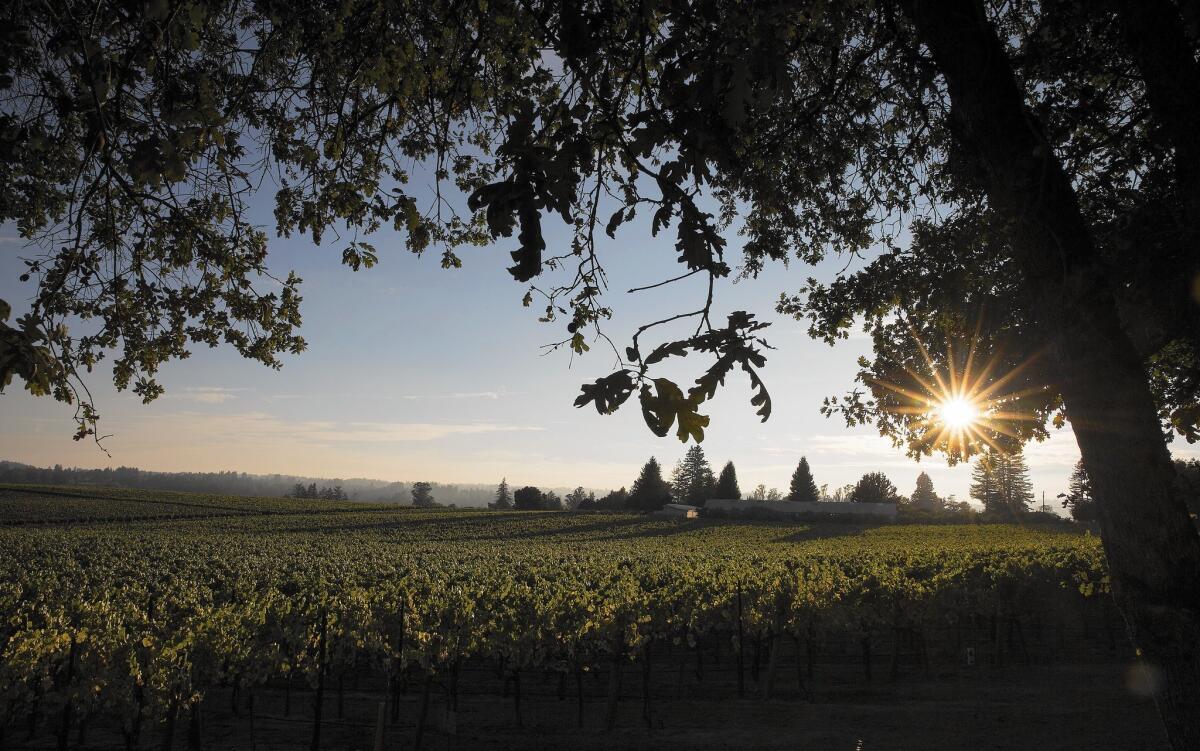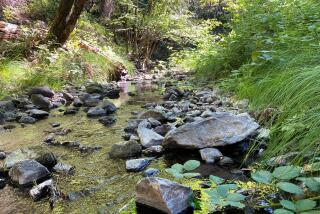Sonoma County residents’ battle with wineries is about more than water

Reporting from SANTA ROSA, Calif. — These days, the redwood-shaded creek by Laura and Ray Waldbaum’s house is a bone-dry path of rocks and gravel, its occasional stagnant pools a somber reminder of the salmon that once thrived there.
Fewer than 500 endangered coho now wend their way from a network of such creeks to the Russian River and out to sea, and the Chinook population is barely two-thirds of what it ought to be, according to wildlife officials.
The Waldbaums and many other rural Sonoma County residents blame wine: about 60,000 acres of vineyards, 439 wineries and 221 event centers that have permission to host 2,299 dinners, concerts, weddings and other events for as many as 32,176 people, largely under the guise of agricultural promotion.
Seven years ago, so many vineyards switched on their sprinklers to protect their vines from a spring cold snap that water levels in creeks feeding the Russian River dropped several feet in a matter of hours, suffocating 25,000 fish in two counties.
So when state water regulators this summer announced emergency drought restrictions to protect salmon in some of those same watersheds, residents were shocked to find that agricultural properties faced no water cutbacks.
Simmering resentment at the rapid growth of vineyards and wineries turned to fury against an industry that has a $13.4-billion impact on the Sonoma County economy. And it appears to have spoiled the party for wineries and growers who have embarked on a highly publicized effort to be the nation’s first wine region to be certified as completely “sustainable” by 2019.
That agricultural exemption is coming to an end, even if the war is not. The State Water Resources Control Board on Wednesday began sending “informational orders” requiring growers to provide details about where they get their water, how much they use and how they apply it. Growers still won’t have to match residents’ water use cutbacks, although some have voluntarily done so.
The two-week rollout of the regulations, which also cover wells, is being closely watched by the state’s $46-billion agriculture industry, which will face similar groundwater regulation over the next few years.
NEWSLETTER: Get the day’s top headlines from Times Editor Davan Maharaj >>
“It’s good that the state is cracking down, but it’s not enough,” said berry farmer and environmental activist Shepherd Bliss.
Tito Sasaki, head of the Sonoma County Farm Bureau’s water committee, said the orders will do little to save salmon this summer.
“I think it’s rather late to get such information and to come up with any sort of a new directive,” Sasaki said. “So, I don’t quite understand what they’re trying to do, and I wonder if they are just trying to see how much they can use their power.”
The Russian River watershed, covering 1,500 square miles in Mendocino and Sonoma counties, is a closed-loop water system isolated from the vast public water projects that plumb the Sierra Nevada to sate the thirst of cities and irrigate the crops of the Central Valley, the state’s agricultural heartland.
On paper, it has enough water to go around. Fall and winter storms drop about 40 inches of rain — many areas get far more — that swells creeks enough to allow salmon to swim from the ocean into mountain creeks.
Longtime residents along creeks that drain the coastal range and inland Mayacamas Mountains recall spawning salmon that were as long as their arm, fat as their thigh and more abundant than carp in a park pond.
The Waldbaums would toss meal worms and grasshoppers into an 8-foot-deep pool along Mark West Creek, northeast of Santa Rosa, and watch the surface “boil” with feeding salmon. Farther west, in Forestville, Richard Hersh and his neighbors would watch salmon hurtle through a culvert that shunts Green Valley Creek under a nearby road.
“This is not a fisherman’s tale; it was like watching a National Geographic show,” said Hersh, who has lived near Green Valley Creek since 1981. “Gradually, gradually, gradually over the years the population has been dramatically decreasing, and in the last four or five years it has been catastrophic.”
Even in dry years, Mark West Creek gets enough water to meet the needs of residents and vineyards 80 to 150 times over, according to the Center for Ecosystem Management and Restoration, a public-private partnership involved in water issues. But it cannot support those demands during the summer.
Juvenile salmon no longer survive long enough for the rains to ferry them to sea.
Since the 2008 frost, when growers hastily withdrew water to cover new vine shoots with protective ice, hydrologists have suspected that wells were diverting water that otherwise would have percolated into creeks. The state enacted regulations that have driven some growers to collect winter runoff or resort to fans during freezes.
Vine by vine, wine grapes seem an unlikely nemesis in California’s water wars. A typical vineyard acre requires fractions of an acre-foot of water, compared with 3 to 4 acre-feet for row crops and nuts. Activists say there’s just too many vines per acre, and too many vineyards.
The best vineyard managers tend to be miserly irrigators, deliberately depriving grapes of water to improve wine quality. The industry has been at the forefront of precision irrigation practices that involve complex remote-sensing devices, satellites and drones. Many vineyards have also turned to dry farming, which relies only on rainfall.
“With cabernet, one of the worst things you can have is too much water,” said Brad Petersen, vineyard manager for Silver Oak Cellars and Twomey Cellars. “Nobody wants a cabernet that tastes like bell peppers.”
But practices vary, and activists say the industry’s sustainability program is too reliant on self-reporting, even if an outside party vets the information. The Sonoma County Winegrape Commission has not reported any detailed water use data a year into its sustainability program.
Under pressure from the public, however, the growers’ organization gradually persuaded about half the vineyards along four crucial salmon creeks to slash water use by 25%. That cutback was announced Monday.
Several large wineries have broken ranks with the Farm Bureau’s opposition to reporting well water use. Douglas McIlroy, director of winegrowing at Rodney Strong Vineyards, said it will be “very easy for this side of the community” to report its well water use.
Jackson Family Wines, which owns about 3,200 acres in Sonoma, has agreed to report well water use but wants the state water board to keep individual companies’ data private, said Carolyn Wasem, the winery’s senior vice president for government and regulatory affairs.
“I think from Jackson Family Wines’ perspective, we have nothing to hide,” Wasem said. “We do an enormous amount of water conservation and are trying to work with the agencies to protect resources. We feel not necessarily happy about it, but I think we’re comfortable with it.”
Any reticence from the wine industry feeds the perception among some rural residents that the wine industry is an unstoppable force, used to getting its way.
“You never know when there’s going to be another vineyard in your area until a bulldozer shows up and starts taking down your trees,” said Laura Waldbaum, who has been fighting the expansion of a nearby mountainside vineyard owned by a former partner in Goldman Sachs.
“The wine industry is taking out these full-page ads touting how sustainable they are, and there’s been a huge backlash.... You’re not sustainable, endless growth is not sustainable. Where before, the wine industry was the darling of the community, people are pissed off here now.
“It’s a bigger story than just the water.”
Sonoma County is in a struggle over the meaning of the agricultural lifestyle, said Marc Bommersbach, a small-scale grower who heads the Westside Assn. to Save Agriculture.
On a short stretch of West Side Road, which hugs the shore of the middle reach of the Russian River, the number of wineries has gone from 10 to 27, all of them with large event centers. Such centers may not soak up much water, but they are the most visible evidence of a viticultural arms race that will have to be fueled by water.
Most event centers lack the distribution of big wineries, and focus on direct sales to consumers, a $1.9-billion niche that had double-digit growth rates for five years, according to the trade publication Wines & Vines. They also are tapping into the $2 billion a year that 21 million tourists spend in wine-related purchases, predominantly in Napa, Sonoma and the Central Coast, according to the Agricultural Marketing Resource Center at Iowa State University.
------------
FOR THE RECORD
Sept. 1, 11:02 a.m.: An earlier version of this article reported that direct sales of wine to consumers amounted to $1.9 million annually. The correct figure is $1.9 billion.
-----------
“They’re not just selling wine anymore,” Bommersbach said. “They’re selling parties. They’re selling an experience, more so than the quality of the wine. It’s the migration of urban activity into rural areas.”
Padi Selwyn, of Wine and Water Watch, an activist group spanning four counties, said Sonoma runs the risk of being a “Disneyland for alcohol tourism.”
“This isn’t about the wine industry anymore,” Selwyn said. “It’s real estate speculation; it’s hospitality. We believe we need to get back to true agriculture in Sonoma County.”
[email protected]
Twitter: @LATgeoffmohan
ALSO:
Stock market’s bumpy ride isn’t over, experts say
Will new technology translate into real-world gains?
In strategy shift, CalPERS looks to cut financial risk
More to Read
Inside the business of entertainment
The Wide Shot brings you news, analysis and insights on everything from streaming wars to production — and what it all means for the future.
You may occasionally receive promotional content from the Los Angeles Times.











